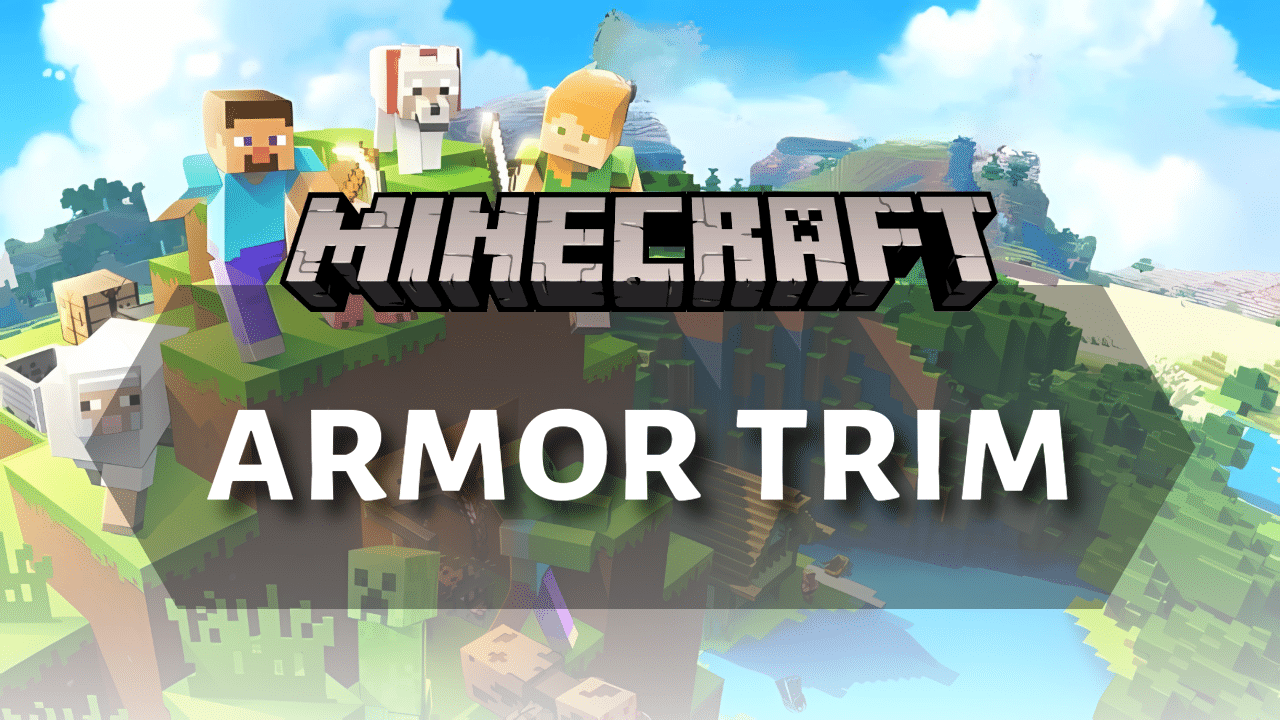
Introduction
Armor trims in Minecraft Bedrock Edition on mobile allow players to express their creativity and personalize their character’s gear like never before. These trims are purely decorative and do not influence the functionality or durability of the armor. They also have no impact on any enchantments applied. By using different armor trim smithing templates in combination with a variety of materials for coloration, players can design striking and unique armor appearances.
Armor trims are applied using a smithing table, and the process introduces a vibrant layer of style to your in-game look. This feature began as an experimental addition and has since become a fully realized part of the game, now offering 18 distinctive trim designs for players to discover and enjoy. This Minecraft Bedrock Armor Trim Guide will walk you through the process of finding and applying armor trims, so you can create armor that reflects your unique style in Minecraft Bedrock Edition.
Using Armor Trims
To use armor trims in Minecraft Bedrock Edition, you first need to craft a smithing table, which is an essential block for customizing your armor’s appearance. This table is crafted using two iron ingots placed above four wood planks in a crafting table.
Once created and placed in the world, the smithing table becomes your primary tool for applying armor trims, functioning as a modern upgrade station with a sleek, centered user interface. When you interact with the smithing table, a new UI appears, showing three input slots and a visual armor stand preview. This stand displays how your selected trim and color combination will look when applied to the armor piece, giving you a clear idea of the final result before committing to the change.
To begin the trimming process, place an armor trim smithing template into the first slot of the smithing table’s interface. This template determines the pattern that will be applied. Next, insert the armor piece you wish to modify—this can be any armor made from chainmail, iron, gold, diamond, netherite, or even turtle shell helmets. Note that leather armor and elytra are excluded from armor trimming and cannot be customized in this way.
Finally, choose a coloring material to apply with the trim. This material can be an ingot or crystal and includes options like iron (gray), copper (orange), gold (yellow), lapis lazuli (blue), emerald (green), diamond (cyan), redstone (red), amethyst (purple), quartz (white), and netherite (black). Using the same material as the armor piece often results in a darker, subtler version of that color, adding more visual variety and nuance to your design.
Once all three items—the template, the armor piece, and the coloring material—are in place, the output slot will display your newly trimmed armor. You can then take it and add it to your inventory. Keep in mind that applying an armor trim consumes both the smithing template and the material used for the color.
The armor piece itself remains intact and will retain any enchantments. However, armor trims are permanent and cannot be removed once applied. If you want to change the look later, you can overwrite the existing trim by applying a new template and material. There is no experience point cost for trimming armor, so you’re free to experiment with designs as much as your supply of templates and materials allows.
In addition to applying trims, the smithing table has another important function: it allows players to upgrade diamond gear to netherite. This is done by placing a diamond item into the armor slot, a netherite upgrade smithing template into the template slot, and a netherite ingot as the material. Just like with armor trims, this process consumes the template and material, upgrading your item to a stronger version without resetting enchantments.
Duplicating Armor Trim Smithing Templates
Because applying a trim consumes the template, players often need to duplicate them. This is done using a crafting table. To duplicate a trim, you will need one copy of the trim template, seven diamonds, and a specific block associated with the type of trim. The duplication recipe is structured by placing the trim in the top center slot of the crafting grid, the corresponding block in the center, and surrounding it with the seven diamonds.
Each trim has its own unique duplication block: Coast trims require cobblestone; Dune trims work with sandstone variants like smooth sandstone or chiseled sandstone; Eye trims need end stone; Rib trims are created using netherrack; Sentry and Vex trims both use cobblestone; Snout trims use blackstone; Spire trims require purpur blocks or pillars; Tide trims are made from prismarine variants; Ward and Silence trims use cobbled deepslate; Wild trims need mossy cobblestone; Wayfinder, Raiser, Shaper, and Host trims all require terracotta; Bolt trims are duplicated using blocks of copper or their waxed versions; and finally, Flow trims use the new breeze rod item introduced in trial chambers.
Where to Find Armor Trims in Bedrock Edition
Armor trim smithing templates are found across the game’s many structures and dimensions. Each type of trim is hidden in specific places, encouraging exploration and risk-taking.
The Coast armor trim is located inside shipwrecks scattered throughout oceans in the Overworld. These wrecks often contain one to three chests, and exploring multiple may be necessary to locate the trim. It’s not guaranteed every time, but they’re one of the easier structures to access early in the game.
For the Dune armor trim, players must raid desert temples. These structures have a hidden room beneath the floor, accessible by breaking the blue terracotta block in the center. Be wary of TNT traps hidden below, but if navigated carefully, the chests often contain rare loot including the Dune trim.
The Eye armor trim can be found in strongholds, deep underground in the Overworld. Strongholds house End portals and contain two types of chests: altar chests found in corridors and library chests found in rooms filled with bookshelves. The trim has a higher chance to appear in the library chests, making those rooms particularly valuable.
For the Rib armor trim, adventurers must travel to the Nether and search through Nether Fortresses. These are ominous brick structures with twisting corridors and occasional stairways. Chests tucked away at intersections or dead ends are your best bet for finding this trim.
The Sentry armor trim is found in pillager outposts, tall wooden towers manned by pillagers. The chest at the top of the outpost is where you’ll need to look, and this trim is one of the easier ones to find early in the game due to the frequency of these structures.
To get the Snout armor trim, players must brave the dangerous Bastion Remnants in the Nether. These heavily fortified ruins are home to piglins and piglin brutes. Chests within the remnant can contain the Snout trim, though exploration here requires strong armor and strategic combat skills.
The Spire armor trim is located in the End, within end cities that spawn on the outer islands after defeating the Ender Dragon. These futuristic-looking towers are often home to valuable loot, and their chests—especially those found in the ships floating nearby—may yield the Spire trim.
The Tide armor trim is unique because it’s not found in a chest, but dropped by Elder Guardians, the massive aquatic bosses located within ocean monuments. These underwater fortresses are patrolled by Guardians and three Elder Guardians. Upon defeating an Elder Guardian, there is a chance that the trim will drop, making this one of the few trims that require combat instead of looting.
The Vex armor trim comes from woodland mansions, gigantic structures deep in dark forest biomes. They’re hard to find but contain many rooms, each with the potential for treasure chests. The trim may appear in these chests, and cartographers in villages can sell maps that point to mansions.
The Ward armor trim is one of the riskiest to obtain, hidden deep within ancient cities in the Deep Dark biome. These silent ruins are guarded by the Warden, and sneaking is essential. The trim may be found in chests scattered throughout the city, but the danger level is high.
The Wild armor trim is found in jungle temples, small moss-covered stone buildings in jungle biomes. These contain two chests: one behind a lever puzzle and the other at the end of a trapped corridor. Both chests have a chance of containing the Wild trim.
The Wayfinder armor trim is a unique design that can only be found in trail ruins, which are mysterious, buried structures hidden beneath the surface of the Overworld. These ruins are often surrounded by suspicious gravel blocks, which must be carefully excavated using a brush. To uncover this trim, you’ll need to methodically brush these suspicious gravel blocks, each of which has a chance of revealing the Wayfinder trim smithing template. The design of the Wayfinder trim is inspired by direction and navigation, symbolizing exploration and the spirit of adventuring. It looks particularly striking when paired with lighter armor colors and stands out as a symbol of discovery.
Also found exclusively within trail ruins, the Raiser armor trim carries a bold and angular design, giving armor a more aggressive, elevated appearance. This trim adds a sense of strength and dominance to any armor set, making it ideal for players who want their character to look more formidable. Just like the Wayfinder trim, the Raiser trim is obtained by brushing suspicious gravel blocks with a brush. The Raiser trim’s design is perfect for diamond and netherite armor, where its sharp angles and bold lines really pop.
The Host armor trim is the fourth design found in trail ruins and embodies themes of community, gathering, and protection. Its design feels welcoming yet noble, a great fit for players who like to act as the protector or leader of their group. Just like the other three, players must locate a trail ruin and carefully brush suspicious gravel to uncover this trim. The Host trim looks great on armor that uses brighter or softer trim colors, like emerald or gold, which bring out its warm, inviting visual tone.
The Shaper armor trim, another exclusive from trail ruins, features a more intricate and artistic pattern that gives a refined, crafted look to your armor. It’s ideal for players who want a sophisticated and detailed design. Like the others, this trim is buried within suspicious gravel blocks, and players must use a brush to recover it. What sets the Shaper trim apart is its elegant aesthetic, with curves and edges that make armor feel more ceremonial and unique. Its appearance suggests craftsmanship and control, making it a perfect complement to lighter-colored materials like quartz or amethyst-based trims.
The Silence armor trim is extremely rare and also located in ancient city chests. It has a significantly lower chance of appearing than other trims, making it one of the most valuable and sought-after designs in the game. If you find one, duplicating it before using it is highly recommended.
The Bolt armor trim comes from trial chambers, a newly introduced structure in recent updates. These chambers contain vaults that occasionally drop the Bolt trim, adding an extra element of dungeon crawling to the game.
Lastly, the Flow armor trim is another new addition, found specifically in ominous vaults after completing ominous trials in trial chambers. To begin an ominous trial, you must be under the influence of the Bad Omen effect. These challenges are harder than regular trials but offer higher chances of rare rewards, including the Flow trim.
Rarity of Armor Trims
Not all armor trims in Minecraft Bedrock Edition are created equal when it comes to rarity. Some, like the Silence trim, are exceptionally rare and highly sought after. Found only in ancient cities within the Deep Dark biome, the Silence trim has a mere 1.2% chance of appearing in chests, making it the hardest to obtain. The Rib and Spire trims are slightly more common at 6.7%, found in Nether Fortresses and End Cities respectively—both difficult-to-reach areas that require careful preparation.
Similarly, the Tide trim has a 20% drop rate but can only be obtained by defeating Elder Guardians in Ocean Monuments, a challenging task due to their remote, underwater locations and powerful enemies. The Flow trim, introduced more recently, drops from ominous vaults at a decent 22.5% rate, but reaching these vaults is its own challenge, as they appear only in ominous trials triggered under specific conditions.
Some trims are easier to obtain through more common or accessible structures. The Eye trim has a guaranteed 100% drop rate from stronghold library chests, making it a reliable reward for players preparing to enter the End. The four trail ruin trims—Wayfinder, Raiser, Shaper, and Host—are uncovered by brushing suspicious gravel in trail ruins, each with an 8.3% drop rate. Although the chance per gravel block is low, the large number of suspicious gravel blocks in a single ruin means dedicated players can usually find at least one trim during a full excavation. These ruins are scattered across the Overworld and can be fully uncovered with time, patience, and a brush.
Other trims offer a balance between rarity and accessibility. The Sentry trim has a 25% drop chance from pillager outposts, while the Wild trim in jungle temples has a 33% chance—both found in the Overworld, making them easier to reach.
The Vex trim drops at a generous 50% rate from woodland mansion chests, though the rarity of the structure offsets the ease of acquisition. Mid-tier trims like Coast (shipwrecks) and Dune (desert temples) are reasonably obtainable, while Snout (Bastion Remnants) and Ward (ancient cities) trims are a bit more elusive at 8.3% and 5%. Finally, the Bolt trim, found in trial chamber vaults, sits around 6%, adding one more challenging find to the growing collection of armor trims in the game.
Conclusion
Armor trims are a purely cosmetic feature introduced in Minecraft 1.20 that allow players to personalize their armor using smithing templates. To apply a trim, you’ll need a smithing table, the armor piece, a smithing template, and a coloring material such as a gem or ingot.
As of Minecraft 1.21, there are 18 different armor trim designs, each with its own unique pattern. These trims can be customized using 10 different materials, giving players a wide range of visual combinations.
Smithing templates are scattered across various structures throughout the game world. To collect them all, players must explore places like shipwrecks, desert temples, strongholds, nether fortresses, bastion remnants, end cities, ocean monuments, woodland mansions, jungle temples, ancient cities, pillager outposts, and trail ruins containing suspicious gravel.
Since templates are consumed upon use, they can be duplicated at a crafting table using the original template, seven diamonds, and a specific block that depends on the design.
Armor trims do not affect armor stats or enchantments, but they add a strong layer of visual identity and collectibility, giving players a new way to express their creativity and style in the game.
If you’re looking for more guides, be sure to explore the website for more tips and tricks. Enjoy your adventure, and happy mining!













